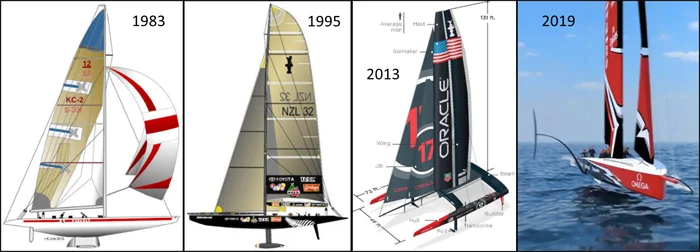HR Digital Transformation - A Business State of Mind (Part 2 of 6)
Why Digital Transformation is Important to HR
Change is Inevitable and constant
Let's get scientific.
The "Kinetic Theory of Matter" states that all particles that make up matter are constantly in motion.
Imagine sitting still in a small raft on the water. The wind, tide or current will still move the raft, but without purpose. Only when these forces are harnessed, is a "force multiplier" (a sail, paddle, and rudder) added, then the raft can begin to move in a specific direction with purpose.
Since we used the raft analogy, let's stay on that track.
The America's Cup Sailing Race is approaching 170 years old. For the first hundred or so years, the technology did not change that much. The hulls were still constructed of wood and the sails were still cloth.

Then in the 2nd half of the 20th century, things started to change…initially with the materials, but later with the instruments. Materials like fiberglass and nylon and polyurethane were introduced that made the hulls stiffer and the sails stronger but also lighter. Racing speeds increased exponentially.

Very late in the 20th century, the speed of change, fueled by rapid advances in technology, further increased speeds and maneuverability.
Materials such as Carbon Fiber and sail and hull designs that look more like a jet wing on a catamaran, with stabilizer bars, have made the craft even stronger and lighter and nimble. State of the art instruments, incorporating Artificial Intelligence and Nano Technology have reduced crew requirements by more than half and have allowed them to make last second adjustments based on changes in environmental weather conditions.
The point to be made with HR Digital Transformation – Technology is a force multiplier
With respect to technology, Moore's Law is the principle that states the speed and capability of computers can be expected to double every two years, as a result of increases in the number of transistors a microchip can contain. Per noted inventor, author and futurist, Ray Kurzweil, "… even if Moore's Law fails in the future, new methods of computing may again set the industry on breakneck development speeds."
Gordon Moore was a co-founder of Intel. According to Intel, Moore's observation transformed computing from a rare and expensive venture into a pervasive and affordable necessity. All modern computing technology we know and enjoy sprang from the foundation laid by Moore's Law. From the Internet to social media and modern data analytics, all these innovations stem directly from Moore and his findings.
The inexpensive, ubiquitous computing rapidly expanding all around us is fundamentally changing the way we work, play, and communicate. The foundational force of Moore's Law has driven breakthroughs in modern cities, transportation, healthcare, education, and energy production. In fact, it's quite difficult to envision what our modern world might be like without Moore's Law.
So, in the context of Moore's Law, Digital Transformation for HR is not a choice. It is a business imperative. If a company resists transformation, the world will still change around it and the longer the transformation is delayed, the greater the upheaval will be if the company even survives.
Don't wait for the fire to know where the fire alarm and extinguishers are located. It is currently estimated that by 2020, 25% of all business apps will not need a screen or keyboard to operate. To survive, HR organizations (in concert with company executives) need to move in a specific direction with purpose. HR needs a Goal of Digital Transformation and a plan to get there.
"You cannot run or hide from the advance of technology. The technology itself is defining the new normal."
Summary
The important takeaway is that as a company and HR organization, it is not possible to run or hide from the advance of technology. The technology itself is defining the new normal. The technology is the primary instigator of employee demands on the business. Thinking digitally, means paying attention to technology to anticipate how it will impact HR and how it will be leveraged to advance the business people processes and increase employee engagement. When a business challenge arises, though the first instinct may be to hire a team to solve it, that will no longer be an option. Thinking digitally also means applying technology to the solution as a first approach.
"HR, in concert with a business imperative from company leadership, needs to think digitally.
HR, in concert with a business imperative from company leadership, needs to think digitally.
In the next part of the series, I will discuss the technologies being employed in HR Digital Transformation applications.
Click here to read Part 1 of HR Digital Transformation - A Business State of Mind article series
About Author
Steve Bradley is Former VP and Director for the Cloud HCM Practice at Birlasoft. He has over 20 years of HCM technology experience – and founder of two HR service companies, SystemLink and Learn2Perform. He is a frequent speaker at conference events and advisor to organizations of all sizes on the topic of HR Digital Transformation, HCM Technology and HR Organizational Change in a technology age.
